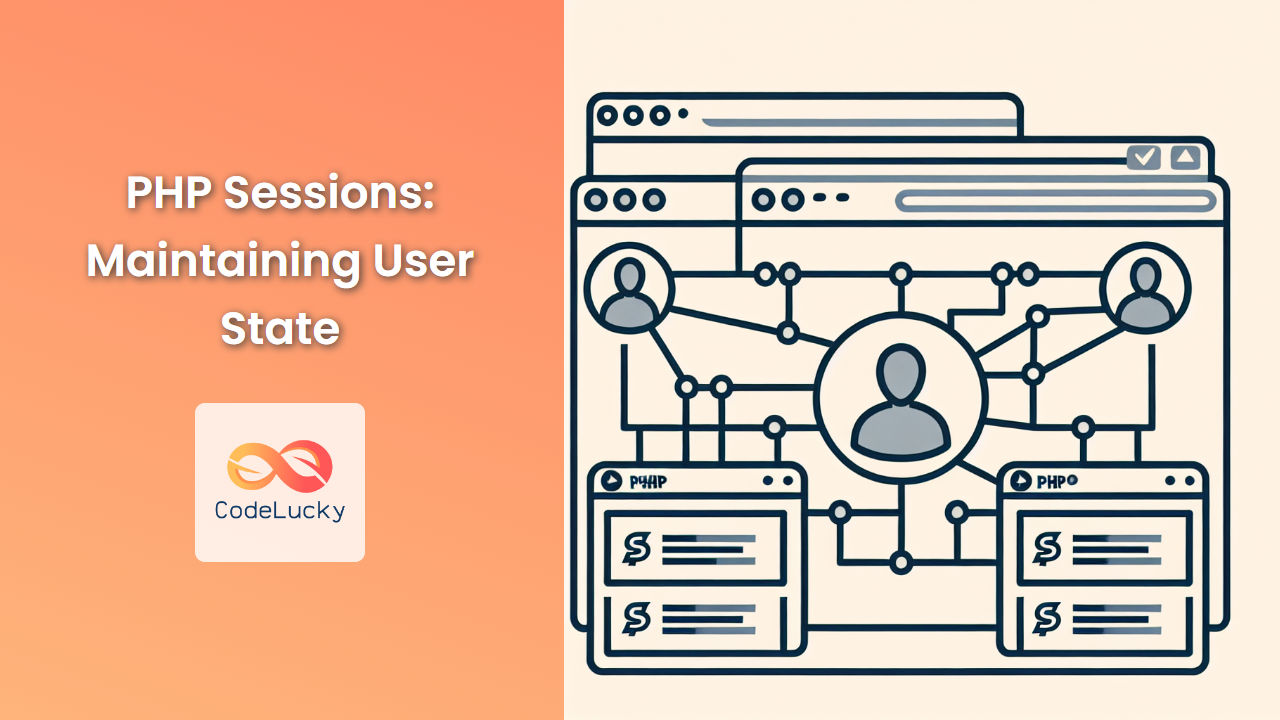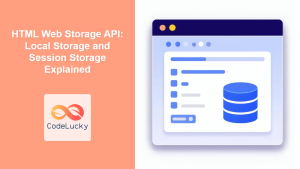In the world of web development, maintaining user state across multiple pages is crucial for creating dynamic and personalized user experiences. PHP sessions provide an elegant solution to this challenge, allowing developers to store and retrieve user-specific data as visitors navigate through a website. In this comprehensive guide, we’ll dive deep into PHP sessions, exploring their functionality, implementation, and best practices.
Understanding PHP Sessions
PHP sessions are a way to store information about a user across multiple page requests. Unlike cookies, which store data on the client-side, sessions store data on the server, making them more secure and versatile.
🔑 Key Concept: A session is initiated when a user visits a website and ends when the user closes their browser or after a specified timeout period.
Let’s start with a simple example to illustrate how sessions work:
<?php
// Start the session
session_start();
// Set session variables
$_SESSION['username'] = 'JohnDoe';
$_SESSION['user_id'] = 12345;
echo "Session variables are set.";
?>
In this example, we use the session_start() function to initiate a session. We then set two session variables: ‘username’ and ‘user_id’. These variables will be available across multiple pages for the duration of the session.
Creating and Destroying Sessions
Starting a Session
To start a session, you must call the session_start() function before outputting any HTML content. This function should be at the very beginning of your PHP script.
<?php
session_start();
// Rest of your PHP code
?>
💡 Pro Tip: Always call session_start() at the top of your PHP files where you need to access session data. This ensures that the session is properly initialized before any operations are performed.
Storing Session Data
Once a session is started, you can store data in the $_SESSION superglobal array:
<?php
session_start();
$_SESSION['user_email'] = '[email protected]';
$_SESSION['login_time'] = time();
?>
Retrieving Session Data
To access session data on subsequent pages, you simply need to start the session and then access the $_SESSION array:
<?php
session_start();
if(isset($_SESSION['username'])) {
echo "Welcome back, " . $_SESSION['username'] . "!";
} else {
echo "Welcome, guest!";
}
?>
Destroying a Session
When a user logs out or you want to clear all session data, you can destroy the session:
<?php
session_start();
// Unset all session variables
$_SESSION = array();
// Destroy the session
session_destroy();
echo "Session destroyed.";
?>
🚨 Important: session_destroy() does not immediately unset the $_SESSION array. To ensure all session data is cleared, it’s good practice to unset the $_SESSION array before calling session_destroy().
Practical Example: User Authentication
Let’s create a more complex example that demonstrates how sessions can be used for user authentication. We’ll create three PHP scripts: login.php, dashboard.php, and logout.php.
login.php
<?php
session_start();
// Check if the user is already logged in
if(isset($_SESSION['user_id'])) {
header("Location: dashboard.php");
exit();
}
// Check if the form is submitted
if($_SERVER["REQUEST_METHOD"] == "POST") {
$username = $_POST['username'];
$password = $_POST['password'];
// In a real application, you would validate against a database
if($username === "admin" && $password === "password123") {
$_SESSION['user_id'] = 1;
$_SESSION['username'] = $username;
header("Location: dashboard.php");
exit();
} else {
$error = "Invalid username or password";
}
}
?>
<!DOCTYPE html>
<html>
<head>
<title>Login</title>
</head>
<body>
<h2>Login</h2>
<?php if(isset($error)) echo "<p style='color: red;'>$error</p>"; ?>
<form method="post" action="">
Username: <input type="text" name="username" required><br>
Password: <input type="password" name="password" required><br>
<input type="submit" value="Login">
</form>
</body>
</html>
dashboard.php
<?php
session_start();
// Check if the user is not logged in
if(!isset($_SESSION['user_id'])) {
header("Location: login.php");
exit();
}
$username = $_SESSION['username'];
?>
<!DOCTYPE html>
<html>
<head>
<title>Dashboard</title>
</head>
<body>
<h2>Welcome to the Dashboard, <?php echo htmlspecialchars($username); ?>!</h2>
<p>This is a protected page. Only logged-in users can see this content.</p>
<a href="logout.php">Logout</a>
</body>
</html>
logout.php
<?php
session_start();
// Unset all session variables
$_SESSION = array();
// Destroy the session
session_destroy();
// Redirect to the login page
header("Location: login.php");
exit();
?>
In this example:
-
The
login.phpscript checks if the user is already logged in. If not, it displays a login form. When the form is submitted, it validates the credentials (in this case, against hardcoded values) and sets session variables if successful. -
The
dashboard.phpscript checks if the user is logged in by looking for theuser_idsession variable. If it’s not set, the user is redirected to the login page. If the user is logged in, it displays a welcome message. -
The
logout.phpscript destroys the session and redirects the user back to the login page.
🔒 Security Note: In a real-world application, you should never store passwords in plain text. Always use secure hashing algorithms like bcrypt to store and verify passwords.
Advanced Session Concepts
Session Hijacking Prevention
Session hijacking is a security threat where an attacker steals a user’s session ID to gain unauthorized access. To mitigate this risk:
- Use HTTPS to encrypt all communication.
- Regenerate session IDs periodically:
<?php
session_start();
if(!isset($_SESSION['last_regeneration'])) {
regenerate_session_id();
} else {
$interval = 60 * 30; // 30 minutes
if(time() - $_SESSION['last_regeneration'] >= $interval) {
regenerate_session_id();
}
}
function regenerate_session_id() {
session_regenerate_id(true);
$_SESSION['last_regeneration'] = time();
}
?>
Custom Session Handlers
PHP allows you to create custom session handlers, which can be useful for storing session data in databases or other storage systems. Here’s a basic example of a custom session handler that stores sessions in a MySQL database:
<?php
class DatabaseSessionHandler implements SessionHandlerInterface
{
private $db;
public function __construct($db) {
$this->db = $db;
}
public function open($savePath, $sessionName) {
return true;
}
public function close() {
return true;
}
public function read($id) {
$stmt = $this->db->prepare("SELECT data FROM sessions WHERE id = ?");
$stmt->execute([$id]);
$result = $stmt->fetch(PDO::FETCH_ASSOC);
return $result ? $result['data'] : '';
}
public function write($id, $data) {
$stmt = $this->db->prepare("REPLACE INTO sessions (id, data, last_accessed) VALUES (?, ?, NOW())");
return $stmt->execute([$id, $data]);
}
public function destroy($id) {
$stmt = $this->db->prepare("DELETE FROM sessions WHERE id = ?");
return $stmt->execute([$id]);
}
public function gc($maxlifetime) {
$stmt = $this->db->prepare("DELETE FROM sessions WHERE last_accessed < DATE_SUB(NOW(), INTERVAL ? SECOND)");
return $stmt->execute([$maxlifetime]);
}
}
// Usage:
$pdo = new PDO('mysql:host=localhost;dbname=myapp', 'username', 'password');
$handler = new DatabaseSessionHandler($pdo);
session_set_save_handler($handler, true);
session_start();
This custom handler stores session data in a MySQL database, allowing for more scalable and flexible session management.
Best Practices for PHP Sessions
-
Start sessions early: Always call
session_start()at the beginning of your scripts, before any output is sent to the browser. -
Use session timeouts: Set appropriate session timeout values to automatically log out inactive users:
<?php
// Set session timeout to 30 minutes
ini_set('session.gc_maxlifetime', 1800);
session_set_cookie_params(1800);
session_start();
?>
-
Validate session data: Always validate and sanitize session data before using it in your application.
-
Use HTTPS: Implement HTTPS to encrypt session data during transmission.
-
Regenerate session IDs: Periodically regenerate session IDs to prevent session fixation attacks.
-
Clean up sessions: Implement a cleanup mechanism to remove old session data, either through PHP’s garbage collection or a custom solution.
-
Avoid storing sensitive data: Don’t store highly sensitive information like credit card numbers in sessions. Instead, store this data securely on the server and reference it using session variables.
Conclusion
PHP sessions are a powerful tool for maintaining user state and creating dynamic, personalized web applications. By understanding how to create, manage, and secure sessions, you can enhance user experiences and build more robust PHP applications.
Remember, while sessions are incredibly useful, they should be used judiciously and with security in mind. Always validate and sanitize session data, use HTTPS, and follow best practices to ensure your application remains secure and performant.
With the knowledge gained from this guide, you’re now equipped to implement and manage PHP sessions effectively in your web applications. Happy coding! 🚀



















